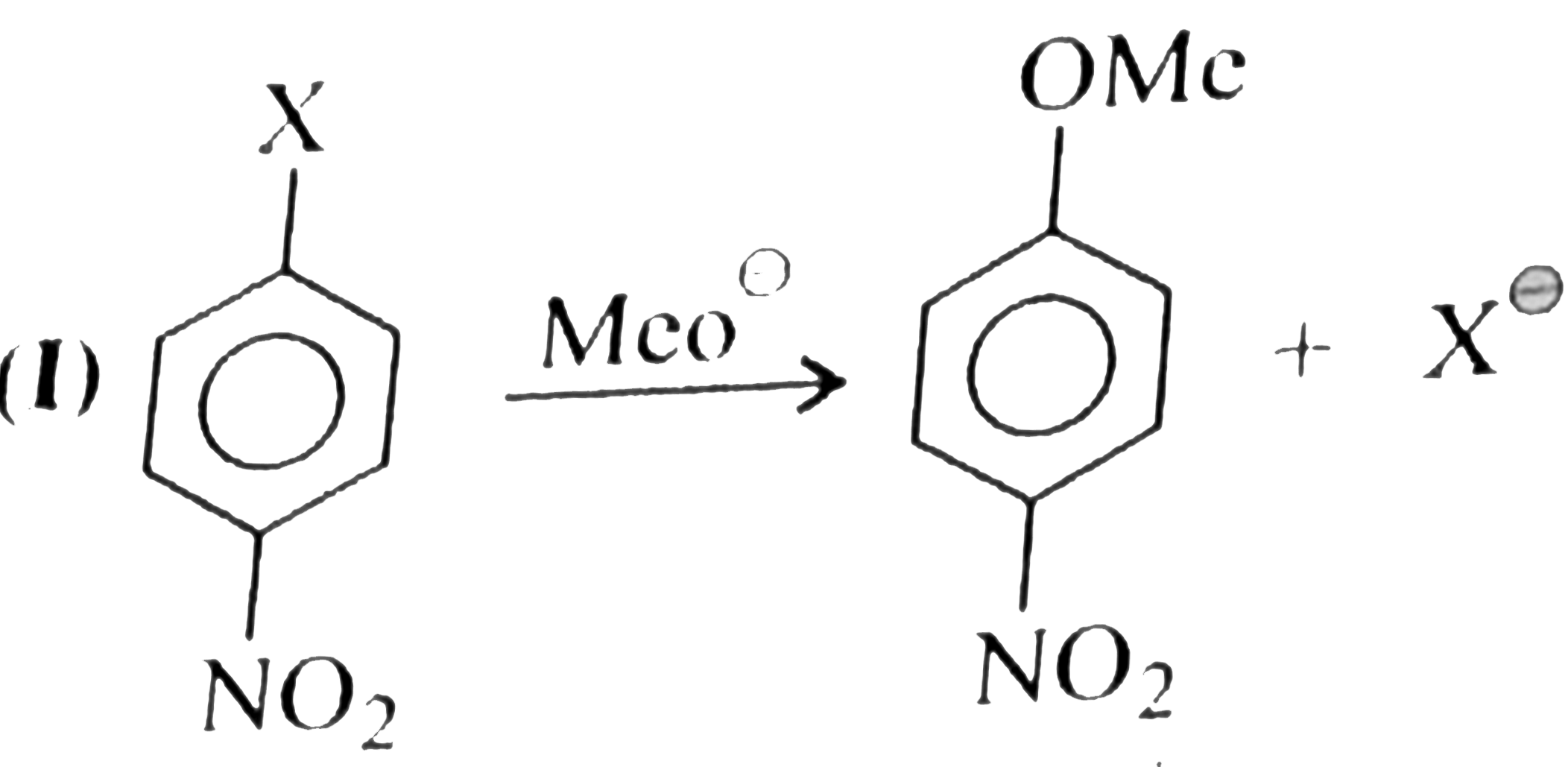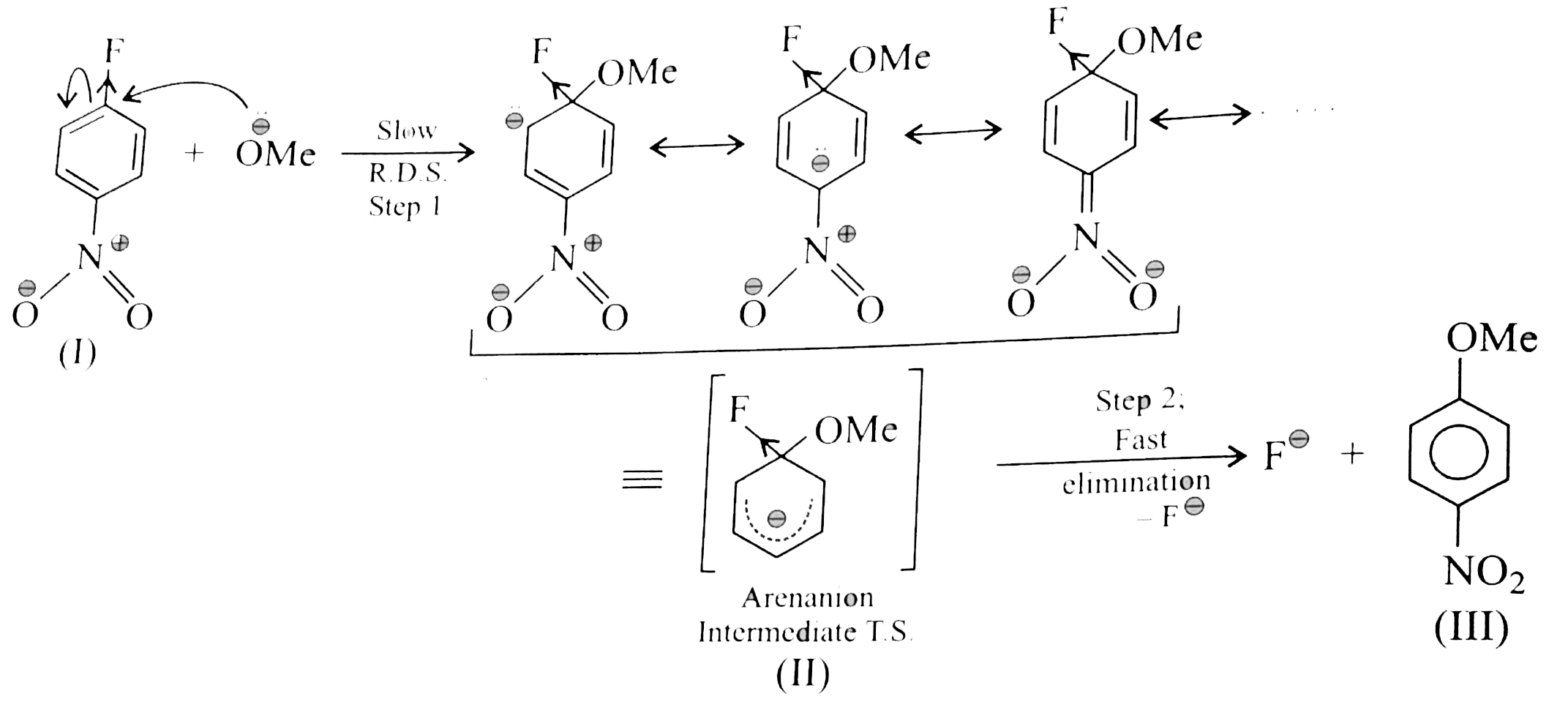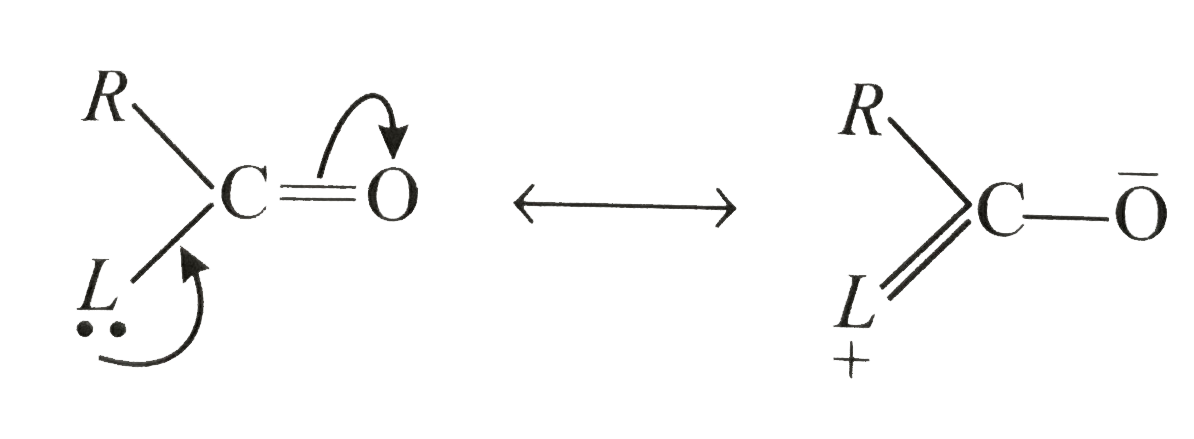For reaction(I) ,why is the order of reactivity of haldies ArF>>ArCl>ArBr>arl,althoughFᶱis a oor leaving group?Explain.
,why is the order of reactivity of haldies ArF>>ArCl>ArBr>arl,althoughFᶱis a oor leaving group?Explain.
En order of halogens:F>Cl>Br>I.
Due to the highENstablishes the negative charge more than other halogens on the neighbouringCatoms in the transitiona nd intermediate states.

This also suggest that step 1 is slow and R.D.if step2 would have been R.D,then the reactivity ofArF would have been the lowest ,SinceFᶱis the weakest leaving group of the halidic ions,step2 is fast since (II)(non-aromatic)change to (III)(aromatic).
(##KSV_CHM_ORG_P2_C11_S01_035_S02.png" width="80%">
Topper's Solved these Questions
- BOOK - CENGAGE CHEMISTRYCHAPTER - AROMATIC COMPOUNDS AND ALKYL AND ARYL HALIDES EXERCISE - Solved Examples21videos
AROMATIC COMPOUNDS AND ALKYL AND ARYL HALIDES
- BOOK - CENGAGE CHEMISTRYCHAPTER - AROMATIC COMPOUNDS AND ALKYL AND ARYL HALIDES EXERCISE - Solved Problems37videos
AROMATIC COMPOUNDS AND ALKYL AND ARYL HALIDES
- BOOK - CENGAGE CHEMISTRYCHAPTER - APPENDIX INORGANIC VOLUME 2EXERCISE - Short Answer Type179videos
APPENDIX INORGANIC VOLUME 2
- BOOK - CENGAGE CHEMISTRYCHAPTER - BIOMOLECULESEXERCISE - Exercises Archives (Analytical And Descriptive)8videos
BIOMOLECULES
Similar Questions
Knowledge Check
- Question 1 - Select One

The correct order of reactivity of I, II & III towards addition reactions is:AI gt III gt IIBI gt II gt IIICIII gt II gt IDIII gt I gt II - Question 2 - Select One
The general reaction is expected to follow decreasing order of reactivity as in(t-Bu = tertiary butyl group)
At-Bul > 1-BuBr > t-BuCl > -BufB1-BuF > -BuCl > t-BuBr > t-BulCt-BuBr > 1-BuCl > t-Bul > t-BuFDt-BuF > t-BuCl > t-Bul > 1-BuBr - Question 3 - Select One
The reactivity of acid derivatives in general follows the order :
_E01_761_Q01.png)
The above order of reactivity can be explained in terms of the :
(i) Basicity of leaving group (ii) Resonance effect (iii) Inductive effect Weaker is the basic character of leaving group, more is the reactivity of acid derivative. In general, all the acid derivatives show resonance as follows:
_E01_761_Q02.png)
More is the stablization, lesser is the reactivity and vice-versa.
Acid derivatives although contain −O∣∣C− group, yet do not undergo the usual properties of carbonyl group. It is due toAinductive effectBresonanceCelemenric effectDall of these
Explain why : ICl is more reactive than I2 ?
View SolutionThe order of reactivity of alcohols in the esterification reaction is :
Primary > secondary > tertiary. Justify.View SolutionThe reactivity of acid derivatives in general follows the order :
_E01_761_Q01.png)
The above order of reactivity can be explained in terms of the :
(i) Basicity of leaving group (ii) Resonance effect (iii) Inductive effect Weaker is the basic character of leaving group, more is the reactivity of acid derivative. In general, all the acid derivatives show resonance as follows:
_E01_761_Q02.png)
More is the stablization, lesser is the reactivity and vice-versa.
Acid derivatives although contain −O∣∣C− group, yet do not undergo the usual properties of carbonyl group. It is due toView SolutionThe reactivity of acid derivatives in general follows the order :
_E01_759_Q01.png)
The above order of reactivity can be explained in terms of the :
(i) Basicity of leaving group (ii) Resonance effect (iii) Inductive effect Weaker is the basic character of leaving group, more is the reactivity of acid derivative. In general, all the acid derivatives show resonance as follows:
_E01_759_Q02.png)
More is the stablization, lesser is the reactivity and vice-versa. Which of the most reactive acid derivative ?View SolutionThe reactivity of acid derivatives in general follows the order:

The above order of reactivity can be explained in terms of the:
(i) Basicity of leaving group (ii) Resonance effect
(iii) Inductive effect
Weaker is the basic character of leaving group, more is the reactivity of acid derivative. In general, all the acid derivatives show resonance as follows:

More is the stabilization, lesser is the reactivity and vice -versa.
Acid derivatives although contain −CO∣∣C− group yet do not undergo the usual properties of carbonyl group. It is due to :View Solution

